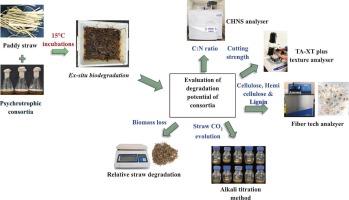Comparative paddy straw degradation potential of Psychrotrophic Fungal Consortia and Pusa Decomposer at low temperatures
Q1 Environmental Science
引用次数: 0
Abstract
Low temperatures impose a major limitation on microbial activity, restricting nutrient utilization and slowing the decomposition of crop residues in cold regions. This study investigated the degradation potential of psychrotrophic fungal consortia in comparison with Pusa Decomposer (PD) at 10, 15, and 20 °C. Among the tested consortia, MC 1 comprising Penicillium aethiopicum LTF 1, Penicillium echinulatum LTF 13, and Penicillium chrysogenum LTF 21 proved the maximum degradation efficiency. MC 1 attained a Relative Degradation Rate (RDR) of 43.63 ± 4.61 % and a C:N ratio of 46.33 ± 1.52 on finely chopped straw (2–3 cm) after 42 days which outperforms PD and other consortia. Significant reductions in straw Cutting Strength, Total Cellulose (TC), Total Lignin (TL), and Total Hemicellulose (THC) contents were recorded, alongside the highest mineralizable carbon and decay rates as indicated by cumulative CO₂ evolution assays. Temperature quotient (Q5) values confirmed optimum degradation efficiency at 15–20 °C. Scanning electron microscopy revealed clear structural modifications in MC 1 treated straw, consistent with advanced degradation. Collectively, the results highlight MC 1 as a promising psychrotrophic consortium for efficient paddy straw decomposition under low temperature conditions, with potential applications in sustainable residue management and nutrient recycling in cold agroecosystems.

低温条件下枯养真菌和Pusa分解者对水稻秸秆降解潜力的比较
低温对微生物活动造成了很大的限制,限制了养分的利用,减缓了寒冷地区作物残茬的分解。本研究研究了在10、15和20°C条件下,与Pusa Decomposer (PD)相比,精神营养真菌联合体的降解潜力。其中,由埃塞俄比亚青霉LTF 1、青霉LTF 13和青霉LTF 21组成的mc1菌群降解效率最高。mc1在秸秆(2 ~ 3 cm)上的相对降解率(RDR)为43.63±4.61%,C:N比为46.33±1.52,优于PD和其他菌株。秸秆切割强度、总纤维素(TC)、总木质素(TL)和总半纤维素(THC)含量显著降低,可矿化碳和腐烂率也显著降低。温度商(Q5)值证实了在15-20°C时的最佳降解效率。扫描电镜显示,mc1处理后的秸秆发生了明显的结构变化,与深度降解一致。综上所述,MC - 1是低温条件下水稻秸秆高效分解的一种有潜力的心理营养组合,在低温农业生态系统的可持续秸秆管理和养分循环中具有潜在的应用前景。
本文章由计算机程序翻译,如有差异,请以英文原文为准。
求助全文
约1分钟内获得全文
求助全文
来源期刊

Bioresource Technology Reports
Environmental Science-Environmental Engineering
CiteScore
7.20
自引率
0.00%
发文量
390
审稿时长
28 days
 求助内容:
求助内容: 应助结果提醒方式:
应助结果提醒方式:


